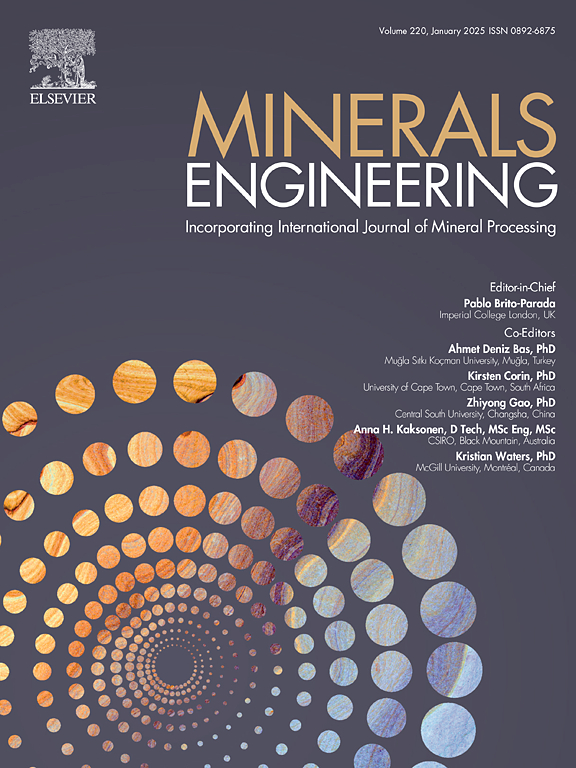矿物颗粒床中上升气泡的滑动相互作用及附着效率
IF 4.9
2区 工程技术
Q1 ENGINEERING, CHEMICAL
引用次数: 0
摘要
浮选动力学基本上是由气泡-颗粒碰撞、附着和剥离相互作用决定的。本文提出了一种新颖的单泡浮选方法和基于含矿床的数学框架来分析和量化附着相互作用。通过排除碰撞和脱离相互作用的影响,将浮选速率常数直接与泡粒附着效率联系起来,从而为快速浮选动力学创造了有利条件。为了达到这个目的,设计了简单的实验,在哈利蒙德管的底部引入单个气泡,通过固定的矿物颗粒床上升。我们开发、比较并验证了包含斯托克粒子和非斯托克粒子的解析(非惯性)和数值(惯性)解的数学模型。利用滑动时间的非惯性模型,推导了诱导时间模型和附着效率模型,建立了与浮选动力学数据的联系。单泡浮选实验证实了宏观浮选与微观泡粒附着机制的相关性。我们的数值分析和解析分析证实了滑动时间模型受气泡尺寸的影响,而五个近似模型在颗粒尺寸方面表现出差异。值得注意的是,在理论适用范围内,流体阻力对滑动时间的影响比颗粒惯性更大。利用我们的模型成功地量化了气泡表面粒子运动的运动学参数。这种新型的浮选系统和工具为研究气泡颗粒的附着和收集机制提供了一个完整的实验和理论框架,为推进浮选理论和开发高效浮选设备提供了有价值的见解。本文章由计算机程序翻译,如有差异,请以英文原文为准。

Sliding interaction and attachment efficiency of rising bubbles in a mineral particle-laden bed
Flotation kinetics are fundamentally governed by bubble-particle collision, attachment, and detachment interactions. This study presents a novel single-bubble flotation approach and a mathematical framework based on a mineral-laden bed to analyse and quantify the attachment interaction. It directly links the flotation rate constant to bubble-particle attachment efficiency by excluding the effects of collision and detachment interactions, thus creating favourable conditions for rapid flotation kinetics. To achieve this, simple experiments were designed with single bubbles introduced at the bottom of a Hallimond tube, rising through a stationary mineral particle bed. We developed, compared, and validated mathematical models incorporating analytical (non-inertial) and numerical (inertial) solutions for Stokesian and non-Stokesian particles. Using the non-inertial model for sliding time, we derived an induction time model and an attachment efficiency model to establish a connection with flotation kinetics data. Single-bubble flotation experiments confirmed the relevance of macroscopic flotation and microscopic bubble-particle attachment mechanisms. Our numerical and analytical analyses confirmed that the sliding time model is influenced by bubble size, while five approximate models showed differences regarding particle size. Notably, within the range of theoretical applicability, fluid drag exerted a more substantial influence on sliding time than particle inertia. The kinematic parameters of particle motion on the bubble surface were successfully quantified using our models. This novel flotation system and tool provide an integrated experimental and theoretical framework to investigate bubble-particle attachment and collection mechanisms, offering valuable insights for advancing flotation theory and developing high-efficiency flotation equipment.
求助全文
通过发布文献求助,成功后即可免费获取论文全文。
去求助
来源期刊

Minerals Engineering
工程技术-工程:化工
CiteScore
8.70
自引率
18.80%
发文量
519
审稿时长
81 days
期刊介绍:
The purpose of the journal is to provide for the rapid publication of topical papers featuring the latest developments in the allied fields of mineral processing and extractive metallurgy. Its wide ranging coverage of research and practical (operating) topics includes physical separation methods, such as comminution, flotation concentration and dewatering, chemical methods such as bio-, hydro-, and electro-metallurgy, analytical techniques, process control, simulation and instrumentation, and mineralogical aspects of processing. Environmental issues, particularly those pertaining to sustainable development, will also be strongly covered.
 求助内容:
求助内容: 应助结果提醒方式:
应助结果提醒方式:


